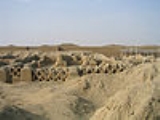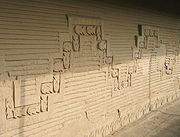
Chan Chan
Encyclopedia

Pre-Columbian
The pre-Columbian era incorporates all period subdivisions in the history and prehistory of the Americas before the appearance of significant European influences on the American continents, spanning the time of the original settlement in the Upper Paleolithic period to European colonization during...
city in South America
South America
South America is a continent situated in the Western Hemisphere, mostly in the Southern Hemisphere, with a relatively small portion in the Northern Hemisphere. The continent is also considered a subcontinent of the Americas. It is bordered on the west by the Pacific Ocean and on the north and east...
, Chan Chan is an archaeological
Archaeology
Archaeology, or archeology , is the study of human society, primarily through the recovery and analysis of the material culture and environmental data that they have left behind, which includes artifacts, architecture, biofacts and cultural landscapes...
site located in the Peru
Peru
Peru , officially the Republic of Peru , is a country in western South America. It is bordered on the north by Ecuador and Colombia, on the east by Brazil, on the southeast by Bolivia, on the south by Chile, and on the west by the Pacific Ocean....
vian region of La Libertad
La Libertad Region
La Libertad is a region in northwestern Peru. Formerly it was known as the 'Department of La Libertad" , a political division that generally corresponds to a state in the United States of America...
, five km west of Trujillo
Trujillo, Peru
Trujillo, in northwestern Peru, is the capital of the La Libertad Region, and the third largest city in Peru. The urban area has 811,979 inhabitants and is an economic hub in northern Peru...
. Chan Chan covers an area of approximately 20 km² and had a dense urban center of about 6km². Chan Chan was constructed by the Chimor
Chimor
Chimor was the political grouping of the Chimú culture that ruled the northern coast of Peru, beginning around 850 AD and ending around 1470 AD. Chimor was the largest kingdom in the Late Intermediate period, encompassing 1,000 km of coastline...
(the kingdom of the Chimú), a late intermediate period
Cultural periods of Peru
This is a chart of cultural periods of Peru and the Andean Region developed by Edward Lanning and used by some archaeologists studying the area...
civilization which grew out of the remnants of the Moche
Moche
'The Moche civilization flourished in northern Peru from about 100 AD to 800 AD, during the Regional Development Epoch. While this issue is the subject of some debate, many scholars contend that the Moche were not politically organized as a monolithic empire or state...
civilization. The vast adobe
Adobe
Adobe is a natural building material made from sand, clay, water, and some kind of fibrous or organic material , which the builders shape into bricks using frames and dry in the sun. Adobe buildings are similar to cob and mudbrick buildings. Adobe structures are extremely durable, and account for...
city of Chan Chan was built by the Chimu around AD 850 and lasted until its conquest by the Inca Empire
Inca Empire
The Inca Empire, or Inka Empire , was the largest empire in pre-Columbian America. The administrative, political and military center of the empire was located in Cusco in modern-day Peru. The Inca civilization arose from the highlands of Peru sometime in the early 13th century...
in AD 1470. It was the imperial capital of the Chimor until it was conquered in the 15th century. It is estimated that around 30,000 people lived in the city of Chan Chan.
Chan Chan was added as a UNESCO
UNESCO
The United Nations Educational, Scientific and Cultural Organization is a specialized agency of the United Nations...
World Heritage Site
World Heritage Site
A UNESCO World Heritage Site is a place that is listed by the UNESCO as of special cultural or physical significance...
in 1986. The city is severely threatened by tornadoes from El Niño, which causes heavy rains and flooding on the Peruvian coast. It is in a fertile, well-watered section of the coastal plain. The city's ruins are additionally threatened by earthquakes and looters. Present-day visitors to Chan Chan can enter the Tschudi Complex, believed to be one of the later citadels built in the city. There are also several other Chimú and Moche ruins in the area around Trujillo. This site was discovered by the Conquistador
Conquistador
Conquistadors were Spanish soldiers, explorers, and adventurers who brought much of the Americas under the control of Spain in the 15th to 16th centuries, following Europe's discovery of the New World by Christopher Columbus in 1492...
Francisco Pizarro
Francisco Pizarro
Francisco Pizarro González, Marquess was a Spanish conquistador, conqueror of the Incan Empire, and founder of Lima, the modern-day capital of the Republic of Peru.-Early life:...
.
Architecture
The city is composed of ten walled citadels which housed ceremonial rooms, burial chambers, temples, reservoirs and some residences. Chan Chan is a triangular city surrounded by walls 50-60 feet high. A distinguishable aspect of Chan Chan is that there are no enclosures which open to the north. The tallest walls shelter against south-westerly winds from PeruPeru
Peru , officially the Republic of Peru , is a country in western South America. It is bordered on the north by Ecuador and Colombia, on the east by Brazil, on the southeast by Bolivia, on the south by Chile, and on the west by the Pacific Ocean....
's coast. Northern-facing walls gain the greatest exposure to the sun, serving both to block the wind and absorb sunlight where fog is frequent. The numerous walls throughout the city create labyrinth of passages.
The walls themselves were constructed of adobe
Adobe
Adobe is a natural building material made from sand, clay, water, and some kind of fibrous or organic material , which the builders shape into bricks using frames and dry in the sun. Adobe buildings are similar to cob and mudbrick buildings. Adobe structures are extremely durable, and account for...
brick and were then covered with a smooth surface into which intricate designs were carved. There are two styles of design present in these carvings: one is a ‘realistic’ representation of subjects such as birds, fish, and small mammals; and the other is a more graphic, stylized representation of the same subjects. The carvings at Chan Chan depict crabs, turtles, and nets for catching various sea monsters. Chan Chan, unlike most other coastal ruins in Peru
Peru
Peru , officially the Republic of Peru , is a country in western South America. It is bordered on the north by Ecuador and Colombia, on the east by Brazil, on the southeast by Bolivia, on the south by Chile, and on the west by the Pacific Ocean....
, is located extremely close to the Pacific Ocean
Pacific Ocean
The Pacific Ocean is the largest of the Earth's oceanic divisions. It extends from the Arctic in the north to the Southern Ocean in the south, bounded by Asia and Australia in the west, and the Americas in the east.At 165.2 million square kilometres in area, this largest division of the World...
. In 1998, The "Master Plan for Conservation and Management of the Chan Chan Archeological Complex" is drawn up by the Freedom National Culture Institute of Peru
Peru
Peru , officially the Republic of Peru , is a country in western South America. It is bordered on the north by Ecuador and Colombia, on the east by Brazil, on the southeast by Bolivia, on the south by Chile, and on the west by the Pacific Ocean....
with contributions from the World Heritage Foundation - WHR, ICCROM and GCI. The Plan is approved by the Peruvian Government, with involvement at the highest levels up until today.
Irrigation
In order to increase the amount of farmland surrounding the city, a vast network of canals that diverted water from the Moche river into the area around the city was installed. It was only with the construction of these canals that the city's population could increase. Before the canals were dug, the city relied on a number of wells that were dug up to 15 meters into the ground. Many of the canals to the north of the city were destroyed by a catastrophic flood in c. 1100 AD, which was likely the key motivation for a need for the ChimúChimú Culture
The Chimú were the residents of Chimor, with its capital at the city of Chan Chan, a large adobe city in the Moche Valley of present-day Trujillo, Peru. The culture arose about 900 AD. The Inca ruler Tupac Inca Yupanqui led a campaign which conquered the Chimú around 1470 AD,.This was just fifty...
to refocus their economy towards one rooted in foreign resources rather than subsistence farming.
Threats to Chan Chan
As the world's largest adobe city, the ancient structures of Chan Chan are today threatened by erosion due to changes in weather patterns - heavy rains, flooding, strong winds.Further readings
- Kubler, George. (1962). The Art and Architecture of Ancient America, Ringwood: Penguin Books Australia Ltd., pp. 247-274

